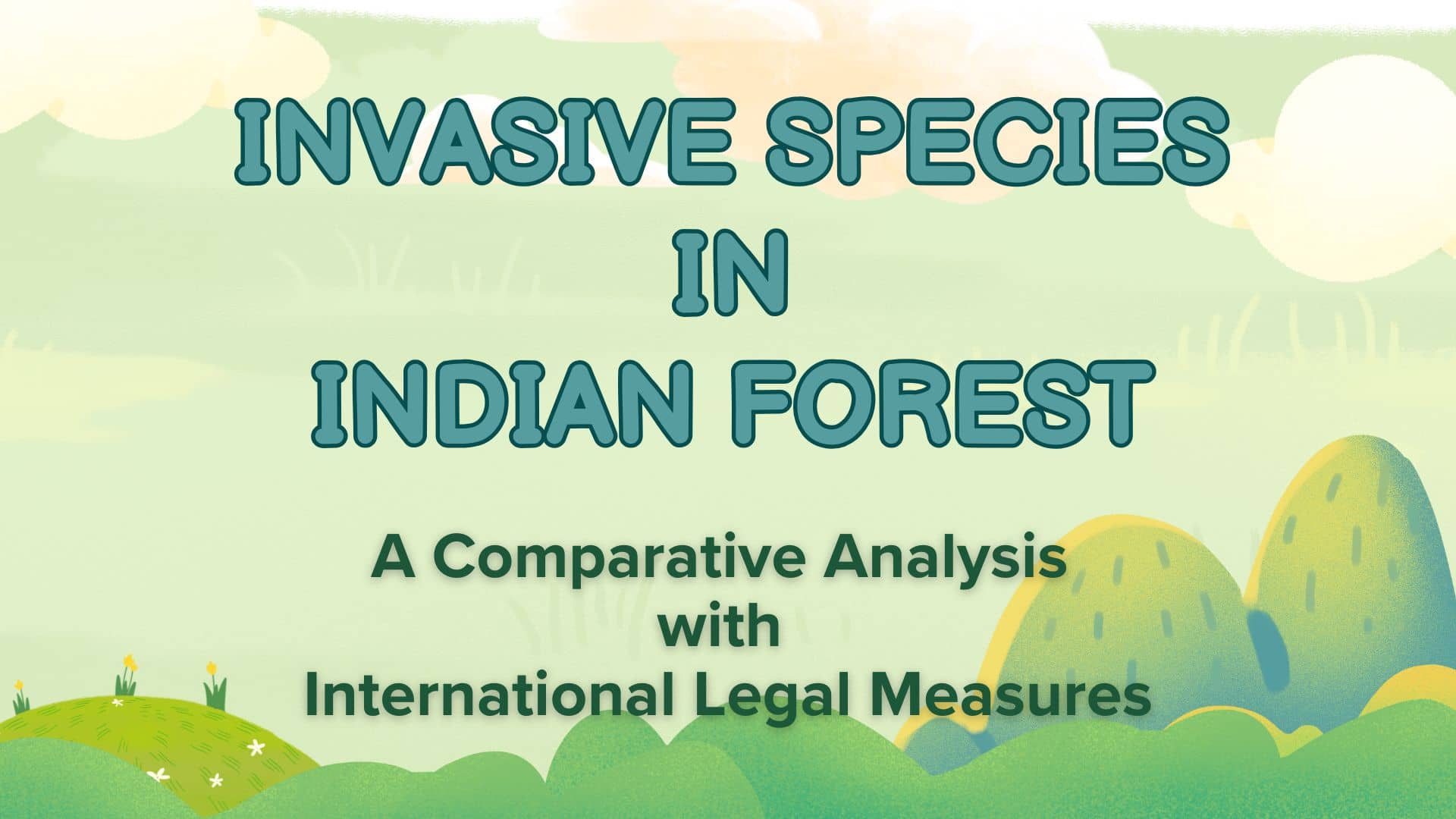Invasive Species in Indian Forest

Table of Contents
Introduction
Invasive species are non-native organisms that cause harm to the environment, economy, or human health. They outcompete native species for resources, leading to ecological imbalance.
Global Context: A leading cause of biodiversity loss worldwide. Affect ecosystems, economies, and human health.
How it Happened
Many invasive species were introduced during colonial times or through global trade and horticulture.
Examples
- Lantana camara (from Central and South America) – Introduced as an ornamental plant, by British.
- Eichhornia crassipes (Water Hyacinth from South America) – Brought for aquatic beauty in ponds.
- Prosopis juliflora (Mexican mesquite) – Introduced for fuelwood and to combat desertification.
Prevalent Invasive Species
Lantana camara (West Indian Lantana):
- Spread across many forests, including the Western Ghats and the Himalayas.
- Forms dense thickets, blocking sunlight and hindering the growth of native understory plants.
- Alters soil chemistry, making it unsuitable for native species.
Eichhornia crassipes (Water Hyacinth):
- Infests water bodies, creating thick mats that deplete oxygen levels.
- Hampers the movement of water, affecting irrigation, fishing, and water transport.
- Provides breeding grounds for mosquitoes, increasing the risk of vector-borne diseases.
Extent of Spread:
- The Ministry of Environment, Forest, and Climate Change (MoEFCC) estimates that over 40% of India’s forest cover is affected by invasive species.
- Certain protected areas, like the Nilgiri Biosphere Reserve, have reported extensive invasion by species like Lantana camara.
Impact on Forest Ecosystems:
- Disruption of native plant communities.
- Threats to endangered and endemic species, such as the Nilgiri tahr and Lion-tailed macaque, which rely on specific habitats.
- Reduction in the availability of forage for herbivores, affecting the entire food web.
Adverse Effects on Ecology
Biodiversity Loss:
- Invasive species outcompete and displace native flora and fauna.
- Example: Lantana camara suppresses the growth of native plants.
Habitat Alteration:
- Changes soil composition and water availability.
- Impacts forest structure and function.
- Disruption of Ecosystem Services:
- Affect pollination, seed dispersal, and soil fertility.
Economic and Social Impacts
Economic Costs:
- Agriculture: Reduced crop yields due to invasive weeds.
- Forestry: Loss of valuable timber and non-timber forest products.
- Management Costs: High expenses for control and eradication efforts.
Social and Cultural Impact:
- Affects the livelihoods of indigenous communities. Dependent on medicinal herbs, etc.
- Loss of culturally significant native species.
Health Implications:
Plants like Parthenium hysterophorus can cause respiratory problems, skin irritation, and allergies in humans.
Legal Frameworks in India
- THE WILD LIFE (PROTECTION) ACT, 1972 amended by The Wildlife (Protection) Amendment Act 2022
- Article 48A of The Constitution of India
- THE BIOLOGICAL DIVERSITY ACT, 2002
- Convention on Biological Diversity, Aichi Target 9, (ratified)
The Wildlife (Protection) Act, 1972
(16A) “invasive alien species” means a species of animal or plant which is not native to India and whose introduction or spread may threaten or adversely impact wild life or its habitat;
62A. Regulation or prohibition of import, etc., of invasive alien species.—
(1) The Central Government may, by notification, regulate or prohibit the import, trade, possession or proliferation of invasive alien species which pose a threat to the wild life or habitat in India.
(2) The Central Government may authorise the Director or any other officer to seize and dispose of, including through destruction, the species referred to in the notification issued under sub-section (1).
The Biological Diversity Act, 2002
- Functions and powers of National Biodiversity Authority—
(1) The National Biodiversity Authority shall, with the approval of the Central Government, make regulations to provide for access to biological resources and traditional knowledge associated thereto, and for determination of fair and equitable sharing of benefits.
(3) The National Biodiversity Authority may—
(a) advise the Central Government on matters relating to the conservation of biodiversity, sustainable use of its components and 1[fair and equitable] sharing of benefits arising out of the utilisation of biological resources;
(b) advise the State Governments in the selection of areas of biodiversity importance to be notified under sub-section (1) of section 37 as 2[biodiversity heritage sites] and measures for the management of such heritage sites;
Challenges in Legal Enforcement

Comparative Analysis
Australia
Biosecurity Act 2015:
Comprehensive Framework:
- Aims to manage biosecurity threats to human, plant, and animal health.
- Includes measures for the prevention, eradication, and management of invasive species.
Border Control and Quarantine:
- Strict quarantine measures at ports of entry to prevent the introduction of invasive species.
- Risk assessment and inspection of imported goods, including plants and animals.
National Priority:
Australia's biosecurity system is a national priority, with a focus on early detection and rapid response to invasive species.
Success Stories
Control of Cactoblastis cactorum
- During the early 1900s, prickly pear, advancing more than a thousand hectares a day, blanketed more than 20 million hectares of Queensland and northern New South Wales in a horror of spines.
- Successful biological control of the prickly pear cactus through the introduction of the Cactoblastis moth.
- Regarded as one of the most successful examples of biological control in history.
Management of Cane Toad
- Ongoing efforts to control the spread of the Cane Toad (Rhinella marina), an invasive species that poses a threat to native wildlife.
- Use of barriers, trapping, and community involvement in removal efforts.


Comments